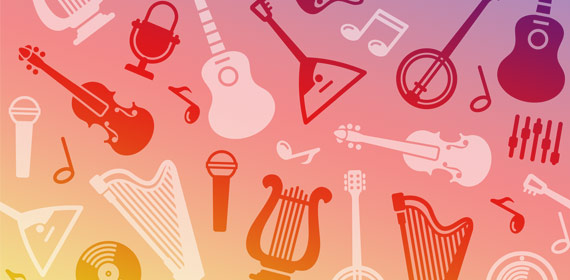Choosing the Right Instrument
- May 9, 2012
- no comments yet

“Hi, I have a 6 six year old who would like to play the guitar.”
“What sparked his interest?”
“He has a friend who plays.”
As I was waiting in the music store for my son’s guitar to be re-strung, this was how the conversation began between the next customer and the young man helping him. They proceeded to look at all kinds of guitars and after about 15 minutes, the customer was convinced to bring in his 6 year old for a lesson on Saturday.
Who knows? This child could turn out to be the next guitar prodigy, but chances are……..Probably not! In all my 20 years of teaching piano, I have definitely concluded one fact: Kids don’t know what they want. They simply don’t! If parents gave in to every little request starting with “I want” we would have some truly confused kids (and broke parents). They naturally want to try every instrument; sometimes two in the same day!
My best advice is to start with piano. It can pretty much be looked at as a “prerequisite” to any other instrument. When you take piano lessons, you learn all the fundamentals needed for any instrument. Let’s look at these fundamentals one at a time.
This child could turn out to be the next guitar prodigy, but chances are……..Probably not!
The notes: When learning the names of the notes, and reading music, the notes are already there for you on the instrument, versus having to find them as you would on a violin (screech!) or a cello, or even a trumpet or trombone. On the piano, if you want to play a G, there is a key that you press down and it makes the sound of THAT note. Assuming your piano is properly tuned, this trains the student’s ear to hear notes the way they should sound so that when you try it on a stringed instrument, you’ll know a little better what to expect. You’ll also be able to hear if you’re playing in tune (most of the time).
Reading music: It’s much easier to learn to read music at the piano because once again, the notes you read are right there on the piano. You just need to press a key and that’s it. You learn both treble clef and bass clef at the same time, whereas most other instruments only use one clef. For example, violin uses treble clef and cello uses bass clef. If you start with one of those instruments, you only master one clef which is a disadvantage if you ever want to play other instruments, such as the piano.
Rhythm: Believe it or not, this is something I work on for a few weeks with new students before even starting to play the piano. It is the basis of every song. Some kids have it naturally and others have to really work at it, but once they hear a song without the correct rhythm, they understand the importance pretty quickly. Lots of drumming and keeping time is crucial to the learning of every instrument. One advantage to learning this on the piano first, is you can always practice the rhythm by having one hand free to tap the beat while the other hand plays (most instruments need both hands to work). This type of practice also develops coordination and learning to do different things with each hand, which is great for those motor skills and finger dexterity!
Singing: Another skill you can develop while learning the piano is the voice, which in turn develops the ear. Once you become a strong reader and learn some basic chords, you can add your voice to it (whereas, if you’re learning a wind instrument first, you won’t be able to sing!) We all know that most kids love to sing, so why not develop their ear early on? Learning the piano really helps with this skill.
The reality is that piano may not be the ultimate instrument for everyone, but it will definitely provide the building blocks and foundation for whatever instrument they choose. There’s no way to tell without trying it out and putting some hard work into it. Music has many benefits and will add to every child’s (and adult’s) life. By starting with some piano basics, their musical options are endless. Have fun putting out those “Good Vibrations!”
Filed in: Kid's Corner, Parents
Leave a Reply
You must be logged in to post a comment.